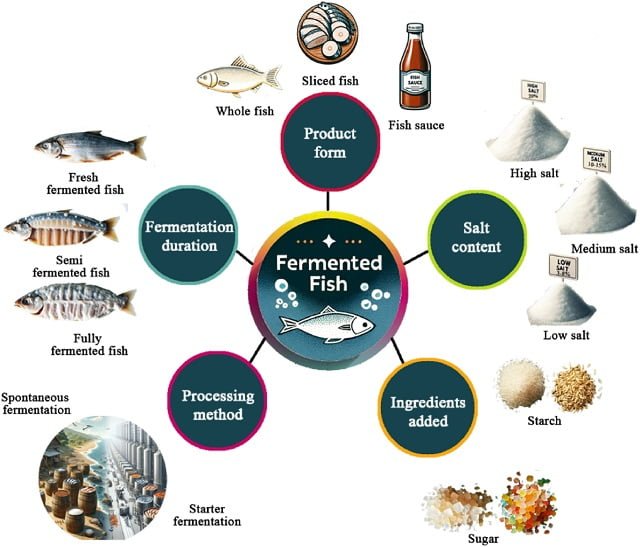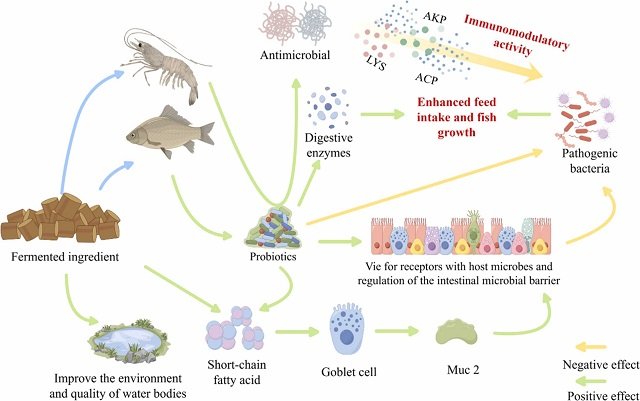
For millennia, humans have turned to fermentation as a natural and effective way to preserve food. This ancient technique not only extends shelf life but also unlocks a symphony of flavors and enhances the nutritional value of various edibles. When it comes to fermented fish, a vibrant category of cultural delicacies worldwide, the starring role belongs to a fascinating group of microorganisms: lactic acid bacteria (LAB).
A team of researchers from Zhejiang Ocean University published a scientific review proposing a focused approach on the deliberate control of LAB metabolism to refine flavor development and safety in fermented fish products, presenting an invaluable reference for the development of starter cultures aimed at improving the quality and safety of these traditional delicacies.
The power of tradition: fermented fish throughout history
- 1 The power of tradition: fermented fish throughout history
- 2 The science behind the flavor: lactic acid bacteria (LAB)
- 3 LAB: Champions of safety and flavor
- 4 Beyond preservation: the modern focus on flavor
- 5 Fermented fish classification system
- 6 Conclusion: refining flavor and safety
- 7 Entradas relacionadas:
Fermentation is an ancient technique with documented use dating back to 2700 BC in Egypt, where fermented mullet (Fesikh) was a staple food. The Romans even had their own fermented fish sauce, ‘garum,’ highlighting the global reach of this practice. Today, fermented fish remains a beloved element in many cultures, offering a wide range of flavors and textures.
The science behind the flavor: lactic acid bacteria (LAB)
The magic behind fermented fish lies in a special group of bacteria called Lactic Acid Bacteria (LAB). These powerhouses convert carbohydrates into lactic acid, creating an acidic environment that inhibits harmful microbes and ensures food safety. Additionally, LAB contribute to flavor development by breaking down proteins into amino acids, which then transform into aroma and flavor compounds. LAB have been employed to eliminate unpleasant odors from fish processing residues.
The scientific review delves into the multifaceted contributions of LAB to the success story of fermented fish. These diverse bacteria act as the driving force behind the fermentation process, shaping both safety and sensory experience.
LAB: Champions of safety and flavor
LAB’s contribution goes beyond mere preservation. They create a safe environment by:
- Reducing pH: The production of lactic acid creates an acidic environment that discourages the growth of harmful bacteria.
- Outcompeting pathogens: LAB outcompete and displace harmful bacteria, further enhancing safety.
- Antimicrobial power: LAB produce bacteriocins, natural antibiotics that inhibit other bacteria.
- Reducing biogenic amines: LAB mitigate the formation of potentially hazardous biogenic amines during fermentation.
But LAB are not just champions of safety; they are also architects of flavor:
Stay Always Informed
Join our communities to instantly receive the most important news, reports, and analysis from the aquaculture industry.
- Protein breakdown: LAB break down proteins into amino acids, the building blocks of flavor.
- Flavor symphony: Through amino acid catabolism, LAB create essential flavor compounds such as aldehydes, alcohols, and esters, resulting in unique and pleasant flavors.
Beyond preservation: the modern focus on flavor
Recent advances in fermentation technology have ushered in a new era. The emphasis has shifted from simply preserving fish to creating an exceptional flavor experience. This highlights the growing importance of LAB-mediated flavor modulation.
Fermented fish classification system
The study proposes a classification system based on five key factors:
- Product form: Whole fish, chunks, pastes, or liquids (e.g., fish sauce).
- Fermentation duration: Fresh, semi-fermented, or fully fermented (affecting the flavor profile).
- Processing method: Spontaneous fermentation (traditional) versus starter culture fermentation (controlled).
- Salt content: High, medium, low, or no salt (influences preservation, flavor, and texture).
- Added ingredients: Carbohydrates (sugars, starches) for microbial growth and flavor development.
Conclusion: refining flavor and safety
The review highlights the fundamental role of fermentation, particularly driven by lactic acid bacteria (LAB), in preserving and enhancing fish products. The main conclusions are:
- Fermentation: a powerful tool: Fermentation extends shelf life, enriches flavor, and improves nutritional value. It offers a safe and healthy alternative to traditional preservation methods.
- LAB: Multifunctional marvels: LAB contribute to:
- Safety: Inhibiting spoilage and pathogenic bacteria.
- Flavor: Creating unique and appealing flavors through fermentation.
Challenges and opportunities:
- Standardization: Ensuring consistent safety and quality through fermentation requires a deeper understanding of the complex microbial interactions and biochemical reactions involved.
- Flavor control: More research is needed to identify specific metabolites that influence flavor and optimize their levels for a superior taste experience.
Future research directions:
- Flavor engineering: The study proposes using specific LAB strains (e.g., Lactobacillus plantarum DZ 3-1 and Companilactobacillus alimentarius DZ 3-6) to control the production of desirable flavor compounds, such as branched-chain aldehydes, to enhance flavor.
- Safety first: While manipulating flavor is important, safety remains the top priority. Selecting LAB strains that lack amino acid decarboxylase activity is crucial to prevent the accumulation of harmful biogenic amines.
In essence, the study advocates for a future of fermented fish and aquaculture products where LAB are harnessed to meticulously control both flavor and safety, creating delicious and healthy foods for consumers worldwide.
The study was funded by the Zhejiang Ocean University Talent Introduction Fund, and the General Scientific Research Project of Zhejiang Provincial Department of Education.
Contact
Zhongjie Yu
Institute of Innovation and Application, Zhejiang Ocean University
Zhoushan, 316022, China
Email: wayuzhongjie@163.com
Wei Jiang
Key Laboratory of Key Technical Factors in Zhejiang Seafood Health Hazards, College of Food and Pharmacy, Zhejiang Ocean University
Zhoushan, 316022, China.
Email: jiangw@zjou.edu.cn
Reference (open access)
Cai, H., Tao, L., Zhou, X., Liu, Y., Sun, D., Ma, Q., Yu, Z., & Jiang, W. (2024). Lactic acid bacteria in fermented fish: Enhancing flavor and ensuring safety. Journal of Agriculture and Food Research, 16, 101206. https://doi.org/10.1016/j.jafr.2024.101206
Editor at the digital magazine AquaHoy. He holds a degree in Aquaculture Biology from the National University of Santa (UNS) and a Master’s degree in Science and Innovation Management from the Polytechnic University of Valencia, with postgraduate diplomas in Business Innovation and Innovation Management. He possesses extensive experience in the aquaculture and fisheries sector, having led the Fisheries Innovation Unit of the National Program for Innovation in Fisheries and Aquaculture (PNIPA). He has served as a senior consultant in technology watch, an innovation project formulator and advisor, and a lecturer at UNS. He is a member of the Peruvian College of Biologists and was recognized by the World Aquaculture Society (WAS) in 2016 for his contribution to aquaculture.




